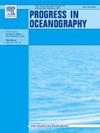Jigsaw puzzle of the interwoven biologically-driven ocean carbon pumps
IF 3.8
3区 地球科学
Q1 OCEANOGRAPHY
引用次数: 0
Abstract
The biological pumping of carbon in the ocean and its effects on ocean carbon sequestration are being studied by researchers from several disciplines. These studies address the biological carbon pump (also called organic, soft-tissue, or biogeochemical carbon pump), the carbonate pump (or counter-pump) and the microbial carbon pump, which are most often treated separately. In the present study, the three pumps are treated together for the first time, under the generic name of “biologically-driven ocean carbon pumps”, in short, “bio-pumps”. The interactions among the carbon fluxes of three interwoven bio-pumps are summarized in the bio-pump jigsaw puzzle.
The bio-pump literature presents a wide range of approaches to the nature and processes of carbon pumps and the ensuing carbon sequestration in the ocean, approaches that often differ significantly. It is shown that sequestration fluxes from all three bio-pumps can occur throughout the water column, albeit in different forms, and this “continuous vertical sequestration” concept is used to propose a target framework to simplify the research on bio-pumps, and unify the studies carried out by researchers from different disciplines. The review of the wide range of approaches to ocean biologically-driven carbon pumping and sequestration in the literature includes both a look back at the initial ocean carbon pump concept and an analysis of current approaches. It also includes estimates of century-scale (≥100 years) global sequestration fluxes in the water column by the three bio-pumps, which are about 1–3, 0.7 and 0.2 Pg C y–1 for the biological, carbonate and microbial pumps, respectively. The value of 0.7 Pg C y–1 appears to be the first ever published for the carbonate pump. The review is followed by detailed analysis of the functioning of the bio-pumps and their carbon sequestration processes, which is organized around four common components, i.e. downward fluxes of biogenic carbon from the upper ocean (i.e. export), transformation fluxes of the exported biogenic carbon in the lower ocean, carbon sequestration fluxes throughout the water column, and upward flux of dissolved inorganic carbon. It is recommended that future carbon-pump publications use representations that include these four components. This leads to a synthetic description of the processes involved in the three bio-pumps and their carbon sequestration, and a proposed unification of research on the interwoven bio-pumps.
交织在一起的生物驱动海洋碳泵拼图
多个学科的研究人员正在研究海洋中的生物碳泵及其对海洋固碳的影响。这些研究涉及生物碳泵(也称有机碳泵、软组织碳泵或生物地球化学碳泵)、碳酸盐泵(或反向碳泵)和微生物碳泵,它们通常被分开处理。在本研究中,首次将这三种泵放在一起处理,统称为 "生物驱动的海洋碳泵",简称 "生物泵"。生物泵文献对海洋碳泵的性质和过程以及随之而来的碳封存提出了多种方法,这些方法往往存在很大差异。研究表明,来自所有三种生物泵的固碳通量可以以不同的形式出现在整个水体中,并利用这一 "连续垂直固碳 "概念提出了一个目标框架,以简化生物泵研究,并统一不同学科研究人员开展的研究。文献对海洋生物驱动的碳泵和固碳的各种方法进行了回顾,包括对最初的海洋碳泵概念的回顾和对当前方法的分析。它还包括对三种生物泵在水体中的世纪尺度(≥100 年)全球固碳通量的估计,生物泵、碳酸盐泵和微生物泵的固碳通量分别约为 1-3、0.7 和 0.2 Pg C y-1。0.7 Pg C y-1 的数值似乎是首次公布的碳酸盐泵数值。回顾之后是对生物泵的功能及其固碳过程的详细分析,分析围绕四个共同部分进行,即上层海洋生物碳的向下通量(即出口)、出口生物碳在下层海洋的转化通量、整个水柱的固碳通量以及溶解无机碳的向上通量。建议未来的碳泵出版物使用包括这四个部分的表述方式。这样就可以综合描述三个生物泵及其固碳过程,并建议统一对相互交织的生物泵的研究。
本文章由计算机程序翻译,如有差异,请以英文原文为准。
求助全文
约1分钟内获得全文
求助全文
来源期刊

Progress in Oceanography
地学-海洋学
CiteScore
7.20
自引率
4.90%
发文量
138
审稿时长
3 months
期刊介绍:
Progress in Oceanography publishes the longer, more comprehensive papers that most oceanographers feel are necessary, on occasion, to do justice to their work. Contributions are generally either a review of an aspect of oceanography or a treatise on an expanding oceanographic subject. The articles cover the entire spectrum of disciplines within the science of oceanography. Occasionally volumes are devoted to collections of papers and conference proceedings of exceptional interest. Essential reading for all oceanographers.
 求助内容:
求助内容: 应助结果提醒方式:
应助结果提醒方式:


